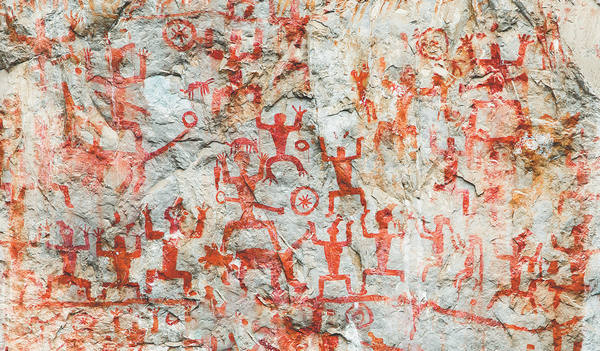Cliffs that sport mystical tattoos
 0 Comment(s)
0 Comment(s) Print
Print E-mail China Daily, June 3, 2022
E-mail China Daily, June 3, 2022

That would be an apt description for the murals in Zuojiang Huashan that stand out red and bright even after thousands of years.
Guangxi Zhuang autonomous region is famous for the picturesque karst landscape in Guilin, its rich ethnic culture-it has over 40 of China's 56 ethnic groups-and silver beaches facing the Beibu Gulf. It also has a World Heritage Site in the form of the Zuojiang Huashan Rock Art Cultural Landscape in Chongzuo, the only rock art entity among China's 55 World Heritage Sites.
There are some 38 rock art sites on steep cliffs some 30-90 meters above the Zuojiang River and its tributary, the Mingjiang. The murals are drawn with a red pigment made of hematite and animal glue and date back to a 700-year period starting from the 5th century BC to the 2nd century AD.The body of work illustrates the life and rituals of the Luoyue people, the ancestors of the current day Zhuang people, who lived in the region about 2,000 years ago. They have all been well preserved thanks to, what the locals reason, the "faithful" protection of the rivers below.
The rock art sites are scattered on mountains that are 221 meters long and 140 meters tall. Altogether, there are 110 groups of around 1,900 discrete images. There are images, all monochromatic, of bronze drums, knives, swords, sheep, dogs and beasts. The biggest human figure is 3 meters tall, and the smallest one 20 centimeters in height.

Each set of figures consists of a giant leader standing at the center, swords hanging by his side. He stands solemnly on a frog-like beast. There are numerous such figures, some scantily clad, others nude. Then there are smaller figures beating bronze drums, paddling canoes, or gathering by the riverside around their leaders.
Most of the human figures on the paintings are stretching out their arms on both sides, and their elbows are bent upwards. They appear to be imitating frog postures, as China Discovery, an online travel agency, says on its website. Frog worship was indeed an ancient Zhuang tradition, and the frog dance still exists. Bronze drums appear in the paintings, and beating bronze drums remains a custom among the Zhuangs today.
Certain human figures have clear gender and age differences. Also, there are figures of pregnant women and children. Some believe that they reflect how the ancient Luoyue people worshipped fertility.
The cliff murals are recorded in Chinese literature of the Ming (1368-1644) and Qing (1636-1912) dynasty period. It remains a mystery how the ancient Luoyue people painted those murals atop those towering cliffs for over 700 years. As also, how the pigments have withstood the tests of thousands of years to still remain bright.
The cliff murals were recognized as cultural relics worthy of State protection in 1988, and as a UNESCO World Heritage Site in 2016 for being the only cultural remnants today of the Luoyue people. The rock art is evidently related to the beliefs of the residents of the area of the time. Today the painted mountains are revered by local people and rituals and sacrifices are performed to appease the invisible forces affecting their lives.
What sets Zuojiang Huashan apart from other rock art is that it is an integral part of the natural system, having survived 2,000 years.
Today, visitors can appreciate the ancient wonder from platforms built on the cliff, or take a boat ride to have a better view of the ancient murals as a whole from the river.
The murals in scarlet stand out atop the emerald mountains, and from a distance they look like the cliffs are sporting mystical tattoos. From up close the numerous thickly dotted figures are a treat to the eye. Experts say, they look like the depiction of a ceremony or a religious ritual of ancient times.
The city museum of Chongzuo, 46 kilometers away from the cliff, provides detailed information about the cliff murals and the ancient Luoyue culture. In some primitive villages near the river, locals still conduct rituals related to the rock art and the virgin forests.






Go to Forum >>0 Comment(s)